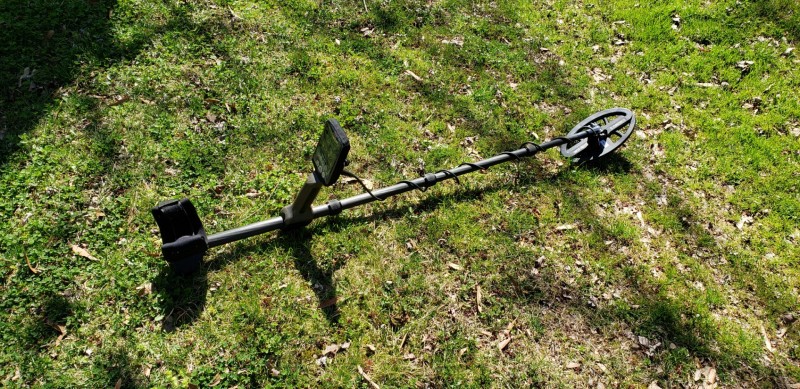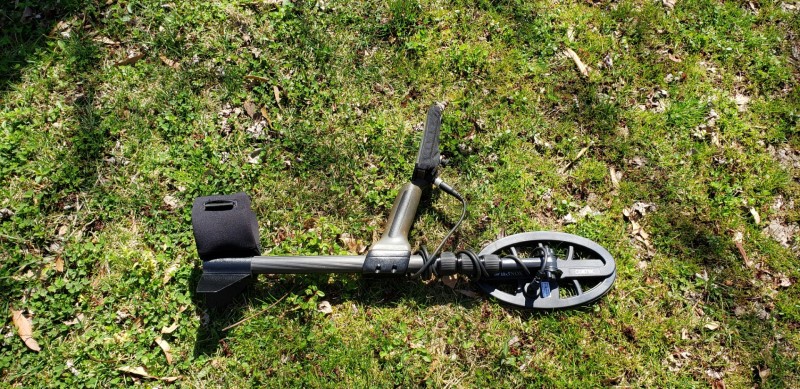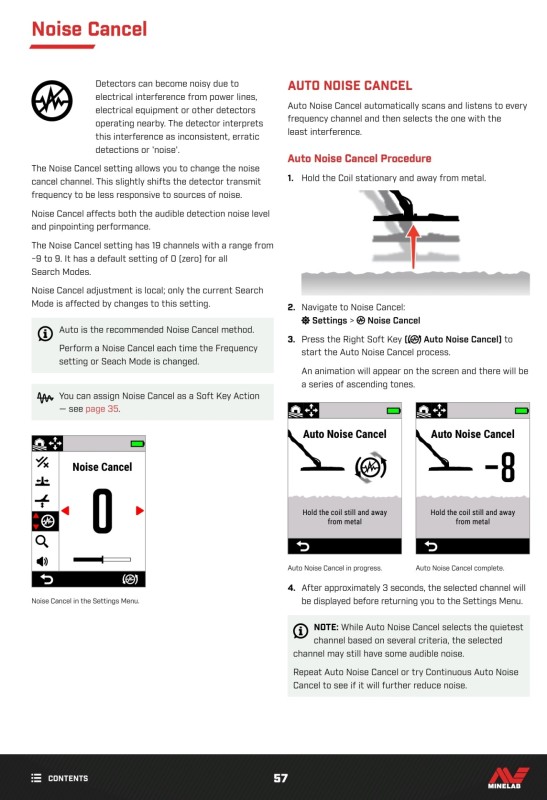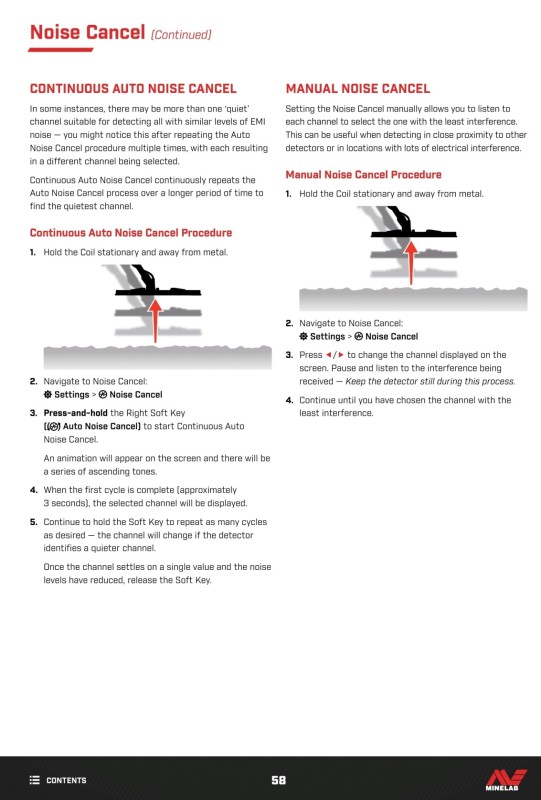-
Posts
6,131 -
Joined
-
Last visited
Content Type
Forums
Detector Prospector Home
Detector Database
Downloads
Everything posted by Chase Goldman
-

Tarsacci Cookbook And Best Practices
Chase Goldman replied to The_Stalker's topic in Tarsacci Metal Detectors
Thanks for this. Not familiar with the fail safe numbers on salt balance, though. I aways start in the mid-40's. -

Tarsacci Cookbook And Best Practices
Chase Goldman replied to The_Stalker's topic in Tarsacci Metal Detectors
I have a Deus 2 and use that 90% of the time, otherwise I'm using a PI in hot dirt. MDT still goes deeper than the D2 in hot dirt and that is the only reason I hang on to it, but I'll go PI first. Everywhere else (beach, park, mild dirt relic, machine gun iron, canslaw infested), the D2 kills it for me. So it's a very niche application where its worth messing with, namely: high iron the PI can't handle in hot dirt where I am going for depth beyond what the D2 can deliver. Thanks. I start with 43 too, it's hard for me to figure how to adjust it from there, though. Not sure how the fertilizer translates to my magnetite hot soils, but it's something. You lost me though when you said with high salt balance the machine gets dull even on low sensitivities. How do you determine that? What is telling you that the machine is getting dull and I don't understand why you would lower sensitivity in response to dullness. -

Tarsacci Cookbook And Best Practices
Chase Goldman replied to The_Stalker's topic in Tarsacci Metal Detectors
Are you talking non-ferrous Trash or ferrous trash? I find it great for differentiating non-ferrous from ferrous at depth in hot dirt, especially using mixed audio. But as a relic hunter, the MDT would be the last machine with which I would venture into an area polluted with aluminum or similar non-ferrous trash due to it's tonal limitations and sub-par ID stability. The thing I struggle with most is how to set up salt balance in hot dirt. It's different than at the beach and I have found no tried and true methodology, it's really hit or miss. Any hints and tips on how you adjusted salt balance settings at hot dirts sites would be appreciated. Regarding the lost nuggets of MDT technical info at Aaron's site, there was also a PDF compendium and summarization of MDT notes cherry picked from threads on Dankowski Detectors. Do a Google search on "Tarsacci MDT 8000 Usage Notes" and it will hit on the Part 1 and Part 2 PDFs you can download and use for future reference. -
Chuck, yeah it is definitely APTX-LL grade which means you can fall anywhere between 20 to 40ms latency also there are sometimes gotchas when mixing and matching these transceivers. For example, I've had transceivers that will transmit in APTX-LL mode no problem but only will receive in non-APTX. It's somewhat hit or miss. Also, pairing these devices "blind" (i.e., without a smart phone display, etc. can be frustrating because it is hard to be sure if they paired up to each other or to some other BT device. That's why I generally only use these Rx/Tx boxes as transmitters, hooked up to the audio source (detector) and use a BT APTX-LL compatible headset. On my Minelab GPX I have moved on from the BT APTX-LL "poor man's" setup and instead have settled on using the Garrett Z-Lynk system to provide wireless audio. It just works and it also allows me to integrate my wireless AT Pro Carrot into the mix. This obviously does not help Gone Bush, but it is what it is. One other proprietary solution I can recommend are the Quest wireless rigs. They also just work, are reliable, weatherproof, cost effective, and low latency. The only thing that gives Z-Lynk the edge for me is the wireless pinpointer integration.
-

New To Detecting, Question About 1 And 2 On Vdi
Chase Goldman replied to Gary985112's topic in Minelab Equinox Forum
I'm not Gerry, Steve, or Andy, but based on my limited experience with the Nox over the past 5 years, I agree that with the Nox disc and notch settings are generally indistinguishable but in my "there are no absolutes in metal detecting" mindset, I cannot say with certainty that discing the ferrous zone will have no adverse effect on a fringe signal that is IDing near that disc setting based on my personal experience. I know that Iron Bias definitely has an impact. My point was really in response to a poster who said disc in modern detectors is basically like a notch...and I just wanted to point out that generalization does not hold true across the board. On Deus and Deus 2 Disc definitely does not equal Notch. Not sure about Legend. On Manticore, I believe the Disc/Notch behaves similar to the Nox. I also wanted to point out that I have seen videos that demonstrate how increasing upper ferrous limits on a Manticore can make a non-ferrous target become masked in the presence of adjacent ferrous targets, so there is definitely an effect there can cause target masking if you overdo it on the ferrous falsing cancellation filter (AKA ferrous limits) - which is really just relearning the lesson from "Filters 101 for Metal Detecting" - bottom line cliche' alert>too much of a good thing can be bad, all settings can have unanticipated adverse consequences, and there are no free lunches. FWIW. -
Yep. It's APTX LL. Don't know if it is available in Oz, though. For hot climes I recommend the Avantree Torus (you can use the ample loudspeaker (it rests on your shoulders, around your neck) or switch to the built-in earbuds) - it is not inexpensive at $90US but it is highly compatible with all BT APTX-LL devices and has great audio fidelity out of the speakers or earbuds. You can definitely plug your earbuds into the recommended Trond transceiver. You can plug a twin into the detector as the transmitter. Total outlay is about $60US plus the cost of the earbuds. For plugging into the detector, I can also recommend the 1Mii transmitter/receiver (similar to the Trond, but with 5.2 compatibility including APTX Adaptive as will as APTX LL) APTX Adaptive is the updated APTX low latency codec that is replacing the obsoleted APTX-LL codec.
-

New To Detecting, Question About 1 And 2 On Vdi
Chase Goldman replied to Gary985112's topic in Minelab Equinox Forum
I agree it’s real. Similar issues arise with Manticore while adjusting its ferrous limits (different than discrimination) and on Deus 2 - Discrimination can affect signal processing and is not just an audio suppression feature as D2 has a separate setting for that called notch. Anyway, just wanted to clarify, however that the effect you are seeing is not a reduction in sensitivity so much as a reduction in unmasking/recovery for those fringe targets. In a practical sense it manifests the same as a perceived loss of sensitivity, but it’s more like cranking reactivity/recovery way up (which clips the target audio response) than turning sensitivity down. FWIW. -

Dimitar Throw The Faithful Few A Bone
Chase Goldman replied to Ridge Runner's topic in Tarsacci Metal Detectors
Dunno if Ditimar will come on, but Dimitar might…😉 Chuck - what about all these other great VLF machines that ARE happening in your lifetime (Nox 700/900, Manticore, Deus 2, Legend, Quest V80…all released or about to be released in just the last year)? You can see where the manufacturers are going and it isn’t single frequency. It’s unfortunately getting harder for Tarsacci to make a splash much less compete…so hopefully Dimitar does have something unique up his sleeve again that can turn some heads away from these established players… -

Can Anyone ID This Relic?
Chase Goldman replied to Capphd's topic in Metal Detecting For Coins & Relics
What's on the other side? -

M8 & M15 Coils Price And Availability?
Chase Goldman replied to Ringtail's topic in Minelab Manticore Forum
You can still do that with the 800/900. Not sure the M-core really brings anything more to the table in that regard, anyway. Now that the 900 comes with a collapsible shaft, I can bring it and the 6" coil along in a day pack while I swing my main rig. -
Let us know what type of soil you are generally dealing with (mild or hot/mineralized?) - that can help make us make more useful recommendations because frankly I have used Relic, General, Sensitive, and Deep HC as base programs for relic hunting in different soils and situations. Relic is deep and works for just about every soil situation I've encountered. I set IAR from 3 to 5 to enable ferrous tones to be differentiated from non-ferrous PCM Pitch tones and an audible threshold setting I also notch out 00 because of a high pitch tone bug (you will still "hear" it as the threshold will blank) which is usually mineralized ground feedback or tiny ferrous oxides in the soil. I set sensitivity as high as I can and go with a Reactivity of 1 in open field searching. I lower sensitivity into the mid-80's and run reactivity at 2.5 or higher in machine gun iron. I use General as an alternative to Relic in moist fields. Deep HC as an alternative to Relic for deep, high conductive targets and hot dirt, and Sensitive as a change of pace mode or for searching for high conductors in thick iron. For the General, Sensitive, and Deep HC base programs I set disc from 7 to 10, use PCM Pitch tones, set Iron Volume to 3, Audio Response to 4 or 5. I don't use notches on these programs unless I am just going for nickels/high conductors in heavy trash in which case I notch everything up 57, leave a window from 58 to 66, and then notch up to 83 or so. I set up my custom programs adjacent to one another typically straddling Relic so that I can quickly switch between them to interrogate targets. As with relic I adjust sensitivity as high as I can for open field searching and set reactivity as low as I can for the conditions at hand (0 to 1 for open fields, low target densities; 2 to 3 for high target densities). And if I am in machine gun iron, I will lower sensitivity to the mid-80's to lower iron overload/masking and "sift" for non-ferrous masked targets utilizing a high reactivity setting. HTH
-

Are 900 Shafts Available And Compatible For My 800?
Chase Goldman replied to ChuckScrivener's topic in Minelab Equinox Forum
I bought a telescopic shaft a few years back that no longer appears to be available. I found a similar one on eBay here: https://www.ebay.com/itm/374136170390?chn=ps&var=643043211599&norover=1&mkevt=1&mkrid=711-117182-37290-0&mkcid=2&mkscid=101&itemid=643043211599_374136170390&targetid=1263433206214&device=c&mktype=&googleloc=9008150&poi=&campaignid=14859008593&mkgroupid=130497710760&rlsatarget=pla-1263433206214&abcId=9300678&merchantid=6296724&gclid=CjwKCAiA_vKeBhAdEiwAFb_nrcZ9OZGLsyYIhXMcZ0i0igDUu8DoccxRmaU42m-Jv2VJUurCH-P0kBoCM4cQAvD_BwE Here's my compact Nox 800 setup with a similar shaft: -
Lot's of good analysis in your post regarding the comparison of the VDI scales and sensitivity ranges, but just wanted to clarify that ML states that transmit power is reduced not gain/sensitivity in Beach 2 or when the Nox goes into Beach black sand overload mode. So I'm not sure mode plays into the sensitivity variation equation when comparing Nox and Manticore. FWIW.
-
Depends on the type of target, but it is not unusual because just about everything but gold corrodes in that environment. A conductive corrosion induced "halo" can form around the target while it sits in the situ can depress target ID until the target is disturbed and the corrosion halo is broken. Multiple adjacent targets, especially targets of widely different conductivities in the same hole can also exhibit this behavior. This is not unusual behavior for many detectors, but I don't have enough experience with the Legend at the beach to make a judgment as to whether it is better or worse than other detectors.
-
Not sure why you had to negotiate with them, but it probably had to do with the fact that all battery replacements are probably covered by the warranty for the next two years, so they haven't really thought about it from a customer cost standpoint. Probably the main sticking point is that if it has to be factory replaced, then the question of who pays for shipping of the entire detector back to the factory comes to into play. In any event, not something you'll probably have to worry about for several years down the line. If it fails out of the gate (or within the first 2 years), you are covered by the warranty. Considering the cost of the detector, I would imagine anything less than $100 would be considered reasonable (that's 2.5% the MAP of the detector) and I'm sure it's probably half of that. Glad you eventually got a reasonable answer.
-

Manticore And Emi (and The Magic Word -- Depth)
Chase Goldman replied to GB_Amateur's topic in Minelab Manticore Forum
Yep. So that definitely optimizes the quietest channel. But I am trying to reconcile Steve G's point (based on Tom's statements) that it also somehow obviates the need to do Tom's "silent" EMI air test - which implies more than just finding the quietest channel. I will follow up with Tom since he now has my question. Frankly though, I believe I am splitting hairs. I personally have not ever fretted about silent EMI, but the statement is out there by Tom so I'm simply curious. And if the Manticore is really just finding the quietest channel by repeated scans and nothing more, that in itself a decent incremental improvement over Nox. -

Manticore And Emi (and The Magic Word -- Depth)
Chase Goldman replied to GB_Amateur's topic in Minelab Manticore Forum
And I wonder just how it manages to do that. In other words, what is the feedback mechanism that accomplishes that. Looking at Tom D's "contnuous "manual noise cancel" algorithm. He manually gets air test depth data from every channel to determine which one is optimal. I could see Long Press doing that if it had a target to calibrate from. But that is not what is happening, from what I can tell. I wonder if he has done side-by-side comparisons of his manual method and "Long Press". From the Manticore User's Guide. (Note that "Long Press" noise cancel is officiall called "Continuous Auto Noise Cancel"): -

Manticore And Emi (and The Magic Word -- Depth)
Chase Goldman replied to GB_Amateur's topic in Minelab Manticore Forum
I have asked Tom for more insight as to what is really going on with long press noise cancel. Is it just re-scanning what it thinks are the most quiet channels (after a "short press" scan) or is there some additional EMI mitigation going on. I think it's the former and your experience tends to back this up. If it's the latter, the question is "what is the downside then?" - because as Steve H always says, "There is no free lunch". -

Manticore And Emi (and The Magic Word -- Depth)
Chase Goldman replied to GB_Amateur's topic in Minelab Manticore Forum
When I asked Tom D about Depth vs. EMI on Manticore and his "nominal" 23% depth improvement vs. Equinox, this was basically what he was talking about Raw Depth is impacted by: [Detector: Sensitivity + EMI Mitigation (coil power) + Recovery/Separation (processing speed) + Signal Processing(target identification/rejection)] + [Environment: Target Characteristics (conductivity, mass, orientation) + Soil Conditions + EMI present] = Effective Depth. There are so many variables and interdependencies (e.g., you can increase sensitivity if EMI is less severe), there is no pat answer. Tom appears to be saying - in aggregate Manticore provides about 23% more depth than the Nox on average for the range of conditions and targets Tom D encounters. What is interesting is the "range" of performance improvement for Tom D's situations is 67% more depth to 2% more depth, depending on the combination of the above. -
Yeah. Wasn't trying to shoot the messenger, Andy. I know where you were coming from. Just commenting on Tom's info that he presents as "fact" because he throws around these numbers like they're verified data. Sounds like there is growing consensus regarding M-core's above average beach performance capabilities especially compared to the Nox. If that was Minelab's focus and they were leaning heavily on feedback from that demographic, like Tom, then mission accomplished. We'll see if it came at the expense of (or wihout benefit to) other capabilities and modes, such as prospecting.
-

Not Another Deus 2 Comparison Video!
Chase Goldman replied to CPT_GhostLight's topic in XP Deus II Forum
Bingo. With Pitch PCM, audio nuances and subtle distortions are introduced (vs. the cleaner square audio) that can help give telltale clues on things like jagged aluminum canslaw and large pieces of aluminum prior to digging them. I won't say you can rely on it to NOT dig this junk, but it certainly sets your expectations and mindset that you are likely digging junk, such that if it turns out wrong, then you are pleasantly surprised. Another weird side effect of PCM vs. Square audio is that it also changes how your MI-6 wireless pinpointer sounds. I find the "PCM" pinpointer audio to be more dynamic and gives you a better sense of the proximity of the target to your pinpointer to make it more effective at zeroing-in on your target. But it can annoy people like audible itching powder so it's an "acquired taste" and not everyone's cup of tea. That's why it's good XP provides the option of either audio setup. -
NP - glad you got the thread going so we could point Legend folks in the right direction on APTX-LL compatible 3rd party gear. This info had been embedded in the Minelab forum sections because until Nokta intoduced Legend. ML was the only major detector manufacturer to utilize BT APTX-LL for wireless audio.
-
"[A]pprox 23% deeper"- Would love to know how he arrived at that number. By putting an "approximate" but specific number down that tends to sway people that he is espousing fact, yet no objective evidence or background is provided to verify that number. Simply interested in the basis for the "23% deeper" claim? Controlled testing data? Real world "nominal-median-average" target recovery depth data? Ratios of max sensitivity settings? Something else? And yes...even if there is a solid basis for the depth comparison claims, they only apply to the mild sandy soils - not mineralized hot dirt sites.
-
Same here, and I'm an engineer! He writes like he is taking technical shothand notes for himself (probably a habit based on his background). Sometimes this style results in gaps and loss of context that the reader has to infer or fill in. As a result, his comments can occasionally be ambiguous or misinterpreted. And assumptions on his part (because ML is not going to divulge all the proprietary details to an outside tester/contributor) are taken as gospel fact by readers. Like any high profile detectorist, he's very knowledgeable about his primary detecting niche (S. FL beaches and mild soil inland sites) but has less experience outside of that. So it's impossible for him to give useful feedback outside his wheelhouse. That's why ML is getting input from contributors across the globe, not just Tom D. We all have a wheelhouse where we primarily excel (prospecting, salt beach surf, dry sand, hot dirt relics, park coin shooting, etc.) based on the sites we have the most access too and the types of targets we enjoy recovering most. True even for those of us who dabble in multiple different detecting pursuits. My point is only that Tom D. has experience gaps in his detecting resume (as we all do), so tempering his M-core comments by understanding his limited frame of reference and seeking multiple opinions on M-core from multiple sources with diverse detecting experiences is essential for determining the actual strengths and weaknesses of Manticore (despite its versatility) and making an informed buy decision. This forum is one of the best sources for obtaining those diverse points of view on any particular detector. I have had to restrain my early adopter impulses on this one and that's not easy. BUT am glad I did. Not because I think M-core is falling short or is not a great detector (no doubt it is a great detector - at certain tasks), but because I am gaining a better understanding of whether it brings anything to the table that I don't already have with my current detector lineup (D2/Nox 900/GPX, Tarsacci and Legend). Instead, I hopped on the Nox 900 bandwagon because I understood better its plusses and minuses (mostly plusses so far) over the 800. M-core may be in my future, but frankly I haven't found the thing that compels me to spend that much coin for it. I thought the deep high conductor capability was going to be the thing, but Simon's feedback has tempered my enthusiasm on that and D2 is no slouch. The D2 does all I need it to do at the Beach and even bottlecaps are a thing if the past, so I don't see a need to grab one for that task. So it really just comes down to curiosity regarding how I might be able to utilize the 2D screen and Ferrous Limits for relic hunting in mild and hot dirt. It's going to have to jump high to beat the depth, TID stability, and EMI immunity of the D2 on beach and land, Nox and Legend have me covered on the diverse backup SMF detector and 10x5 coil front, Tarsacci on raw VLF depth in mild and hot dirt, and the GPX is the king of depth in the hot dirt relic fields of Virginia. Not sure where M-core and it's $1.6K price tag fits at the moment.
-

Added A Power Bank To My Manticore
Chase Goldman replied to BigSkyGuy's topic in Minelab Manticore Forum
True. The issue is when current is running through the magnetic connector pins. Agreed, but it is amazing how uncommon, common sense is. The cold charging thing is not so obvious, and wanted people to know about it.





